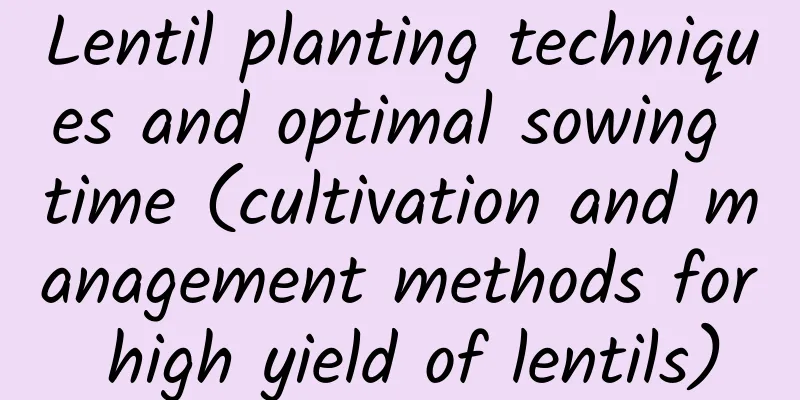Lentil planting techniques and optimal sowing time (cultivation and management methods for high yield of lentils)

How to grow lentilsThe planting method of lentils should be carried out on the basis of respecting their growth habits, including sowing time, plot selection, seed selection and soaking, thinning, pinching and topping, trellising and vine guidance, and timely picking. 1. Sowing timeLentils are usually sown in spring and autumn , but the specific sowing time varies slightly from region to region. For example, in the south and north, the temperature rises earlier in the south, so the planting time should be earlier. The further north you go, the later the planting time. In the same region, the planting time will also be different due to different altitudes. The higher the altitude, the later the planting time . 2. Plot selectionLentils prefer a warm and humid environment with sufficient sunlight and fertile and loose soil. Therefore, if you want to plant on a large scale, you should try to choose a plot that is slightly higher, sunny and ventilated, with sufficient light, deep soil and good drainage. If you want to plant in small quantities, roadsides, fences, courtyard walls and depressions are all suitable. 3. Seed selection and soakingThe seed coat of lentils is smooth and flexible, and it is slow to germinate on its own. Therefore, before planting, select healthy and full seeds, soak them in clean water for about 12 hours to soften the skin, and then plant them. 4. Sowing methodWhen sowing lentils, you can sow them in furrows or holes, but hole sowing is generally the main method. When sowing, you must apply decomposed farmyard manure as base fertilizer, and then sow 3 to 4 seeds per hole. If planting on a large area, the spacing between plants and rows should also be considered, and try to leave enough space after the plants have grown luxuriantly to facilitate light and ventilation, and prevent the occurrence of diseases and pests. 5. ThinningWhen the lentil seedlings grow 2 to 3 leaves, you can remove the sick and weak plants by leaving 2 to 3 plants in each hole to ensure the nutrient supply and growth of the healthy seedlings. 6. ToppingWhen the hyacinth beans grow to about 1.5 meters, you can pinch off the top to make them grow more new branches. 7. Build a trellis to guide vinesLentils have strong stem growth ability and are good at climbing. When they grow to about 1.5 to 2 meters, you can put a 2-meter-high human-shaped support next to the plant and guide the vines onto the support so that they can climb and grow and receive light evenly. 8. Pick at the right timeLentils are mainly eaten by picking young pods. Generally, they can be picked after about 20 days of flowering and when the maturity reaches 60-70%. If it is too late, the pods will lose their crispness and tenderness and have little edible value. Therefore, each batch should be picked in time. When picking, do not pick with flowers on, so as not to reduce the formation of the next batch of pods and affect the yield. Correct cultivation and management of lentils promotes high yieldIn order to achieve high yield of lentils, in addition to meeting its basic growth needs as much as possible during the planting process, attention should also be paid to the maintenance after planting to achieve the goal of high yield. The main maintenance methods include thinning leaves and branches, weeding and loosening the soil, watering and fertilizing, and preventing diseases and insects. 1. Thinning leaves and branchesLentils have a particularly strong ability to branch and grow, and are good at climbing. In the appropriate growing season, they often have lush branches and leaves, and are damp and shady. This is not only not conducive to lighting and ventilation, but also often causes root rot and breeds bacteria and pests. Therefore, it is advisable to remove the dry and yellow leaves and densely grown and crossed branches in time. 2. Weeding and loosening the soilAny plant will have weeds. It may be beneficial to orchards, but it is not good for vegetables and crops. Therefore, it is advisable to clean up the weeds around lentils and loosen the soil to facilitate the breathing and ventilation of the roots to avoid root rot. 3. Watering and fertilizingBecause lentils have strong growth power and luxuriant branches and leaves, they have a greater demand for water and fertilizer, especially during the seasons when the plants are growing vigorously and flowering and pod forming. When it comes to watering, it is advisable to flexibly control it according to the season and weather conditions. Generally, it is best to keep the soil moist and loose. Therefore, if the temperature is high, it is advisable to water the plants thinly and frequently. It is generally best to water them after dinner when the temperature is slightly lower. If the temperature is low, it is advisable to water them thinly or not at all. In terms of fertilization, since lentils have a greater demand for fertilizer from growth to flowering and podding, they can be fertilized in a "concentrated fertilizer and light application" or "thin fertilizer and frequent application" manner. 4. Prevent diseases and insectsDuring the growth of lentils, due to the vigorous growth of stems and branches and the luxuriant branches and leaves, pests and diseases are inevitable, such as gray mold, anthracnose, aphids, red spiders, bean leaf borers, etc. If you have a bacterial disease, you can spray a diluted solution of carbendazim; if you encounter an insect pest, you need to spray a corresponding diluted solution of insecticide. In short, it is advisable to accurately judge the condition and prescribe the right medicine. |
<<: Why do we need to clean the orchard in winter (how to clean the orchard after picking the fruit)
Recommend
Cultivation and care of Christmas cactus in spring, is it better to change the pot in spring or autumn?
1. Cultivation and care of Christmas cactus in sp...
Which month is best to plant bayberry seedlings?
As a widely planted fruit tree, bayberry is favor...
Jabuticaba cultivation methods and precautions
1. Maintenance methods 1. Water: Jaboticaba needs...
Poinsettia Pests and Control Methods
Poinsettia Whitefly Whiteflies like to live in sh...
How to Plant a Pineapple Tree
1. Prepare the land Planting pineapple trees has ...
How to transplant succulents so that they change color (steps for beginners to grow succulents)
How to transplant succulent plants There are usua...
Do lilies like the sun?
Lilies like the sun Lilies like the sun. Dependin...
How to make Chinese cabbage grow core quickly (how to make small cabbage grow core quickly)
Cabbage is one of the indispensable vegetables in...
The efficacy and function of blueberries
The efficacy and function of blueberries 1. Prote...
How to propagate Dracaena by cuttings? Cutting methods and precautions
Dracaena is also called the bleeding tree and the...
Maintenance methods of Jinyumantang bonsai
Jin Yumantang is suitable for growing in slightly...
How to make the leaves of lucky bamboo shiny
1. Wipe the leaves This is the simplest and most ...
Does the money tree need watering in winter? How to water?
The money tree is light-loving and shade-tolerant...
Yellow bell flower language
1. Flower Language Its flowers are large and gold...
Can pink palm be hydroponically cultivated? Hydroponics methods and precautions
Can pink palm be hydroponically cultivated? Pink ...









